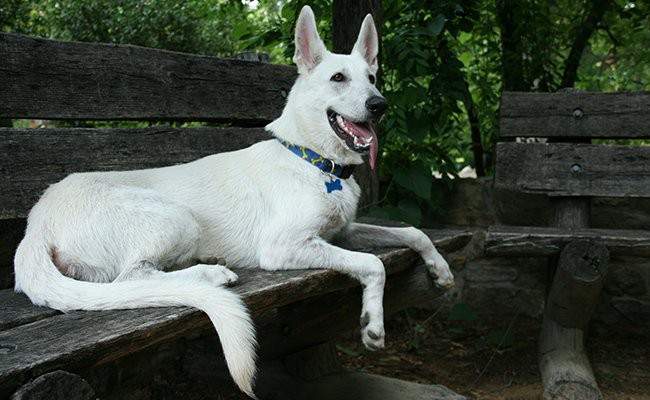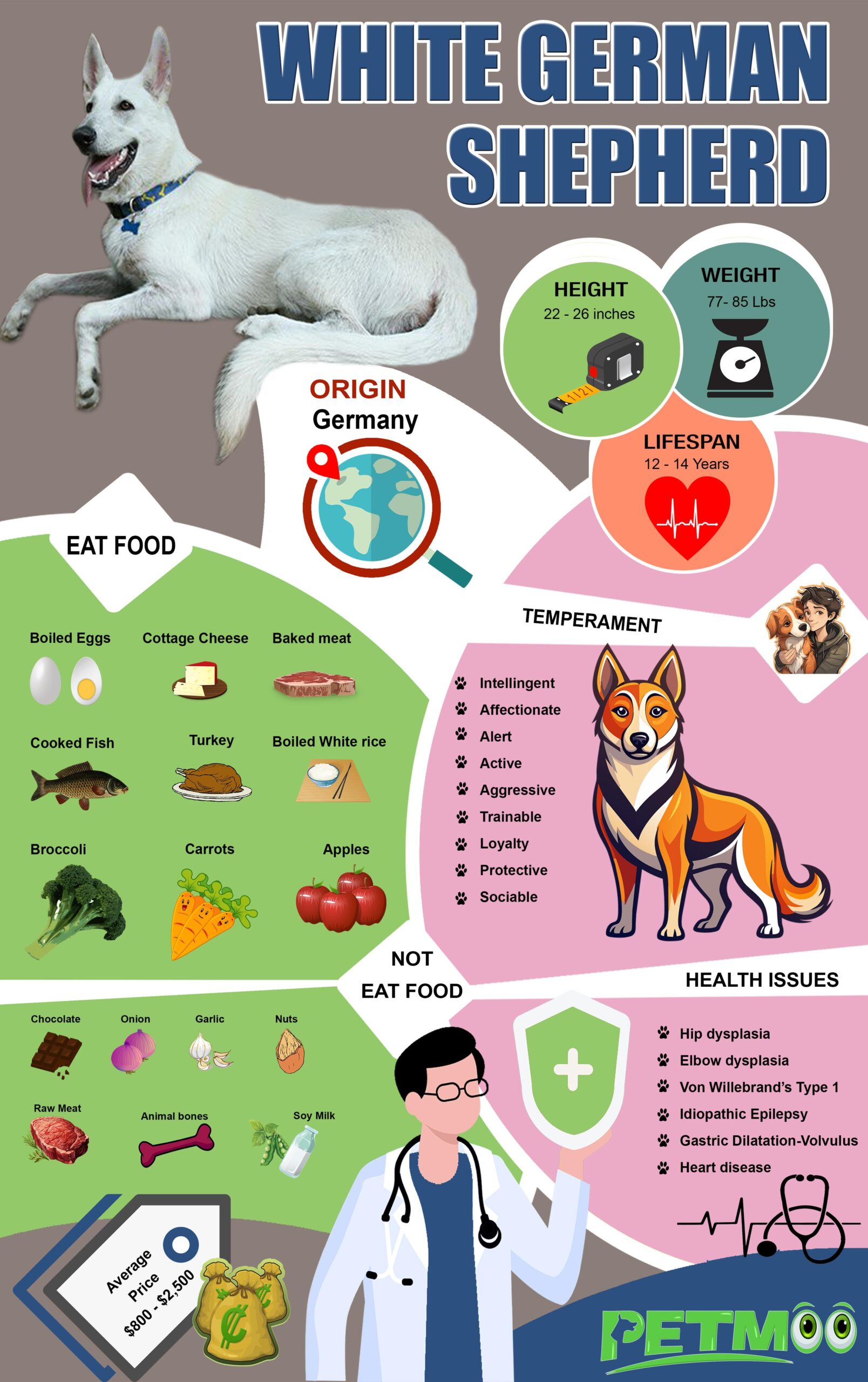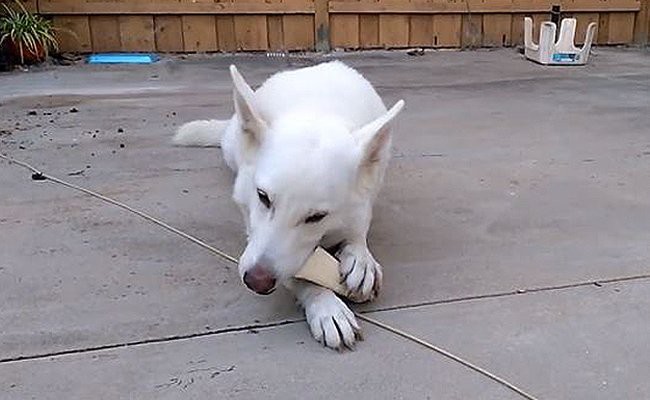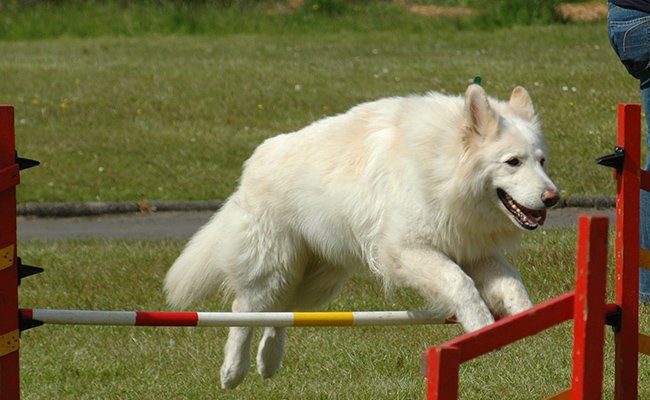Dog Pregnancy Calculator And Timeline
According to a section of breeders and professionals in the vet care industry, white is claimed to be the original color of a German Shepherd dog. But sadly, a white colored German Shepherd is an unrecognized dog by the American Kennel Club since the latter’s confirmation standards do not permit.
White German Shepherd is used as the therapy dog, farm dog, search and rescue, acting in TV shows and movies, police and sniffer service dogs. Let us now learn more about this dog.
White German Shepherd Facts
White German Shepherd Appearance/Coat Color
The White German Shepherd is a medium-sized, muscular and well-balanced dog with a slightly longer body than the leg. The dog has a pure white coat, triangular-shaped straight ears, and a low-set curved tail.
German Shepherds appears in other different coat colors like black and tan, bronze, black, sable, red and black.
It has attractive almond-shaped eyes with a slanted appearance with an intense look. Its eye rim and lips are black. The dog has a black nose.
It has a weather-resistant double coat. The top coat is straight, thick and dense while the undercoat is short, thick and fine.
White German Shepherd Size
The average height of a White German Shepherd is 22 to 26 inches. The average weight of a White German Shepherd is 77 to 85 pounds.
The females are a little lesser in weight and height than the male dogs.
White German Shepherd Lifespan
Generally, White German Shepherd dogs are known and seen to lead a life that can be from 12 years to 14 years. Nevertheless, if the dog is made to lead a healthy lifestyle then there is a high probability of living a couple of more years.
White German Shepherd Temperament
Intelligent – A very smart dog and always quick to understand things and also make its owner satisfied.
Affectionate – Likes to move around with the owner and sits on their lap quite often. Also has a close bonding with the members of the family.
Alert – The dog is extremely alert and even a needle of suspicion arises in its mind, it will instantly send a signal to its owner to be cautious.
Active – The natural character of this dog breed is to keep moving around and hates to sit around idle.
Aggressive – The dog is quite aggressive by nature and can be destructive at times.
Trainable – Although being a rigid and independent dog, the early few days of training can be a real test for the trainer. Nevertheless, a consistently calm and thoughtful trainer will be effective in properly training the dog.
Loves to play with children – A kind of instinctual liking is there in a dog towards children. Having that lively nature, the White German Shepherd dog spends more energy while playing with the children.
Loyalty – The White German Shepherd always remains to be a very loyal dog to the owner.
Protective – The dog works sincerely as a strong guard to the house and family members of the owner.
Sociable – Once the dog undergoes proper socialization training at a very early age itself, it develops that liking to go outdoors and move with people and other pets.
White German Shepherd Foods
Generally, foods that contain a reasonably rich source of proteins and vitamins are recommended for a dog’s diet.
Foods For White German Shepherd
- Commercially brand reputed dry kibble/dog food
- Boiled Eggs
- Yogurt
- Cottage Cheese
- Baked meat
- Cooked Fish
- Turkey
- Lamb
- Boiled White rice
- Green vegetables like spinach leaves and broccoli
- Carrots
- Apples
- Bananas
- Oranges
Do not Eat” Foods
White German Shepherd Training
Right from the time a White German Shepherd dog is brought home by the owner, training needs to be started instantly on various aspects: obedience, housebreaking, potty, crate, and socialization.
Socialization training is a very important aspect as it is about teaching the dog how to behave with strangers and other animals.
Generally, it is recommended to give socialization training to the white German shepherd dog at a very young age since it is known to be aggressive. The dog does respond well to positive and intelligent training.
The trainer needs to be a very consistently patient and intelligent. Positive training means encouraging words given by the trainer to make the dog perform well at training and exercise sessions.
Intelligent training can refer to giving rewards to the dog while training for its good performance.
Dogs Names For Your White German Shepherd
| Male Dogs | Female Dogs |
|---|---|
| Ace | Angel |
| Bruno | Bonnie |
| Captain | Cleopatra |
| Dakota | Dixie |
| Ernie | Elsa |
| Grover | Gloria |
| Hudson | Helena |
| Larry | Jasmine |
| Marshall | Lucy |
| Newton | Nancy |
| Prince | Princess |
| Rudy | Rose |
White German Shepherd Health Problem
The white German Shepherd suffers from the following health problems. Contact your vet if you happen to notice any changes in behavior or food habit.
1. Hip Dysplasia
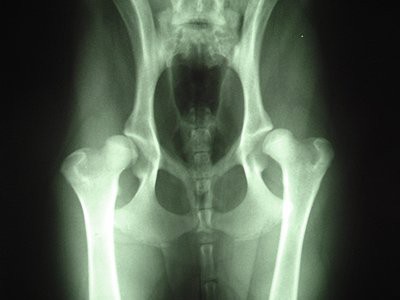
Symptoms
- Lazy feeling that can be read from the dog’s face
- Limited movement of the body
- Difficulty to stand up from a lying position
- Avoidance of activities like climbing or running down the stairs
- Reluctance to exercise
- The looseness of the joints
- The grating sound of the joints while walking
- Lameness in the hind limbs
- Stiffness
- Closely positioned legs while standing (narrow stance)
- Bunny Hop
- Expanded shoulder muscles formed due to continual pressure applied on the front leg to compensate for the handicapped rear leg
Causes
- Genetic disorder
- Poor Diet
- Lack of Exercise
- Excess Weight gain
Treatment
Treatment for hip dysplasia is given based on the stage of the disease.
Dogs with mild hip dysplasia disorder will be instructed by the vet to undergo:
- Dietary changes to reduce body weight so that the hips do not get overstressed
- Physical Therapy
- Not to do exercise on rough surfaces
- Anti-inflammatory medications (non-steroidal anti-inflammatory drugs) and corticosteroid
- Joint fluid modifiers
Dogs in the moderate to severe stage of hip dysplasia are instructed by the vet to undergo:
DPO/TPO (Double pelvic osteotomy/Triple pelvic osteotomy) – The removal of the pelvic bone and rotation of the segments is carried out in this surgery.
The end result will be the betterment of the working of the ball and socket joints. Normally, this surgery is performed on juvenile dogs (below 1 year).
FHO (Femoral Head Osteotomy) – In this surgery, the removal of the femoral head or ball of the hip joint results in the formation of an artificial or false hip joint.
The advantage of such hip joint is that the pain and discomfort suffered by the dog earlier due to hip dysplasia will be lowered substantially.
THR (Total Hip Replacement) – This is the largely noted surgery that is undertaken on dogs affected with severe hip dysplasia.
Total hip replacement surgery works to remove the bad hip of the dog that is replaced with an artificial hip which could be in metal and plastic parts.
2. Elbow Dysplasia
Symptoms
- Lameness in the front leg
- Pain when extending the elbow
- The dogs tend to keep away the affected limb from the body
- Reduced range of body movement
- Fluid build-up in the joint
- The grating sound of the bone and joints while movement of the elbow
- Severe arthritis and painful elbow
Causes
- Abnormal growth of cells or tissue or bone and the result is a deformed elbow joint that undergoes degenerative effects. This is a genetic disorder
- Poor nutrition
Treatment
Two factors determine the nature of the treatment to be given to a dog with elbow dysplasia, namely:
- The extent of pain that the dog suffers and
- Level of arthritic changes to the joint
The aims of the treatment are to restore the functioning of the affected limbs of the dog and also to relieve the affected dog from the pain that it suffers.
Normally, a surgery called Ulnar osteotomy is followed and it involves cutting of the ulna bone. This will decrease the stress of the dog and also the Ununited anconeal process is made to unite in a normal manner in the dog.
After surgery, the vet will give some rehabilitation therapy coupled with few other instructions and exercises for the operated dog.
- To cold pack the elbow joint of the dog for 10-15 minutes every eight hours daily for a period of 3-5 days. The purpose is to regulate the pain and reduce the swelling.
- Rehabilitation therapy like swim therapy, massage, underwater treadmill, therapeutic exercises and joint mobilization
- Anti-inflammatory medications and injections containing Adequanii are given to reduce the pain and
- Cetyl myristoleate could be taken to lessen the extent of weakening of the cartilage
3. Von Willebrand’s Type 1
Symptoms
- Bleeding in the gums or mouth
- Skin bruises
- Sudden bleeding from the nose
- Bladder bleeding which is notable through the blood in the urine
- Gastrointestinal bleeding with bloody stools
- Excess bleeding from the vagina during heat cycles
- Long bleeding time even for small injuries
- The high amount of bleeding while clipping the nails
- Excessive quantity of bleeding during surgeries like spaying or neutering
- Bleeding happening for a long time after breakage of baby teeth
- Anaemic disorder
Causes
Von Willebrand’s Type 1 is a hereditary disease that comes from the parents. Dogs that inherit this disease cannot be cured since no effective medication or surgery has been found yet.
Treatment
Despite Von Willebrand’s Type 1 is an incurable disease, some steps can be taken to manage the disease. The dog owners must ensure that their pet does not even suffer a minor wound.
Likewise, hard-to-digest foods like bones and difficult to chew foods that will cause cut injury or gum bleeding must be avoided.
Dogs affected with Von Willebrand’s Type 1 disease can be allowed for the blood transfusion from other dogs or frozen plasma during emergency times. This will help in controlling the level of bleeding in the affected dog.
DDAVP drug can be given to the donor dogs to enhance their Von Willebrand factor.
4. Idiopathic Epilepsy
Symptoms
- Behavioural changes during the prodrome stage
- Restlessness in the dog during the pre-seizure stage
- During the ictus or seizure stage, a variety of activities might happen. It includes drooling, crying, paddling with paws, bowel and urinary incontinence, vigorous head shaking and thrashing things with legs
- Unconsciousness
- Post-seizure stage, the dog will suffer ataxia (loss of coordination) and temporary blindness (for some minutes or even a few days)
Causes
With respect to idiopathic epilepsy in dogs, there is no known cause. It is only for secondary epilepsy and other types of epilepsy, certain other health problems in the dog can trigger epilepsy.
Treatment
It is essential for every dog owner to closely observe and notify the symptoms prior to a seizure or epilepsy in their pet. Since there are some types of seizures, the nature of symptoms that a dog suffers must be known to the veterinarian.
Then only, the latter can decide on the right treatment method for the epileptic dog. Normally, Phenobarbital and Potassium bromide is given as medications for dogs with epilepsy.
They need to be given on a daily basis. On the other hand, a veterinarian will also conduct liver function tests on the dog in a periodical manner to check the effect of medications on the dog’s liver.
The dosage level of medication given to the dog will be adjusted accordingly by the veterinarian based on the results of this test.
5. Gastric Dilatation-Volvulus
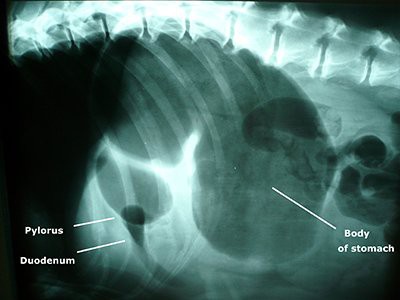
Symptoms
- Restlessness
- Depressed face
- Drooling from the mouth
- Swollen stomach
- Regularly looks at its stomach after every couple of minutes
- Attempts to vomit but it does not happen
After worsening of the condition:
- Gums become pale
- Rapid heartbeat
- Shortness of breath
- Weak feeling
- Collapse
Causes
- Taking food from a bowl that is kept in a raised position
- Eating one heavy meal every day
- Fast eating
- Involve in playing or running instantly after eating its food
- Excessive drinking or eating
- Stress
Treatment
Based on the level of the disease, an affected dog is given the required treatment.
- The vet will release the accumulated pressure on the dog’s stomach after inserting a tube into the dog’s throat that goes down to the stomach.
- In case if the dog has a twisted stomach, a hollow needle will be inserted into the dog’s belly. The needle will go to its stomach and then the pressure will be released. If not possible, the dog will undergo surgery
- Antibiotics could be given
- Intravenous fluids (IV Injections)
- Steroids
- Surgery was done on the dog if there is a twist in the stomach muscle that is becoming complicated and affecting other parts of the body. The emergency surgery will bring back the dog’s stomach to the normal place and make it smoothly function
6. Heart disease
Symptoms
- Reluctance to walk
- Loss of appetite
- Weight loss
- Difficulty in breathing
- Abdominal distension
- Troubled sleep due to persistent coughing
Causes
- Congenital or developmental defects in the heart valves
- Injury to the heart
- Entry of toxins into the body
- Bacterial or viral or fungal infections
- Environmental factors
Treatment
Based on the nature of heart disease, the call for the kind of treatment to the affected dog will be taken by a vet.
Medications
- To make the heart function normally like correcting the uneven rate of heartbeats
- Reduce the pace of fluid build-up in the lungs
- Clear bacterial infections
- Low salt diet to the dogs that will never allow accumulation of fluids in the dog’s body
- Limited exercise for effective weight management and ensure that the dog’s heart does not face excess stress
- Vitamin-B supplements like taurine and carnitine
- Antioxidants such as Vitamin E and CoEnzyme Q
White German Shepherd Price
The average price of a white coated German Shepherd dog is between $900 to $1500. Dogs that are purchased for use as a pet will be economical than the one used as a show dog.
You can get a White German Shepherd dog at more cheaper rates than the specified price range. But you should not forget that you have to compromise at the quality of the dog breed.
However, some key factors determine a dog’s price such as its age, appearance, bloodlines, vaccinated breed, market demand and quality of the breeder. Even eminent breeders follow premium pricing i.e. beyond the above-stated price range.
Reputed breeders sell a white German Shepherd dog from the level of $3,000 and go beyond $6,500.
White German Shepherd Interesting Facts
- There is a wrong belief amongst several people that due to a genetic disorder, the White German Shepherd dog breed carries such an appearance.
- However, this is not the fact. The white colour German Shepherd was bred with the intention of developing an all-white dog from this breed.
- During 1889, a German person named Captain Max Von Stephanitz was the first to breed a White German Shepherd dog.
- In 1999, the White German shepherd dogs were recognized as a separate dog breed by the United Kennel Club, the second biggest dog breed registry in the USA.
- It is indeed strange to learn that the puppyhood of this dog breed extends for three years
- Post World War I, the White German Shepherd dogs became equally popular like the colour-coated shepherds in nations like the United States, Canada and Mexico.
- During 1964, the first White German Shepherd Dog Club was started by lovers of the White German Shepherd dog in Sacramento, California.
- AKC (American Kennel Club)-registered White German Shepherd dogs compete regularly in the performance events conducted by this club. A few examples can be the obedience and tracking events.
- During the second half of the 20th century, this dog breed’s popularity spread to various countries like Canada, Mexico and also globally.
- From 1969, several White German Shepherd clubs were formed in the USA and other countries with the aim of promoting and protecting this dog breed.
- The wrong belief from the 1930s that White German Shepherd dogs have the white coat colour because of a genetic fault was disproved by a scientific research.
- Nevertheless, many hardcore German shepherd lovers did not accept the research results.
White German Shepherd Breeders
White German Shepherd Breeders in the USA
- Ve –Lin’s German Shepherds
Address: 35198 Walnut Street
Barstow, CA 92311
Tel.: 760-253-7280
E-mail Id: hushpup39@earthlink.net - Vom Hundhaus German Shepherds
Address: 3130 46th St N,
St. Petersburg, FL 33713
Tel.: 1-727-687-5338
E-mail Id: gsd@vomhundhaus.com - Von Waldberg German Shepherds
Address: 20730 95th Ave SE,
Snohomish, WA 98296
Tel.: 1-425-402-8899
E-mail Id: info@vonwaldberg.com



